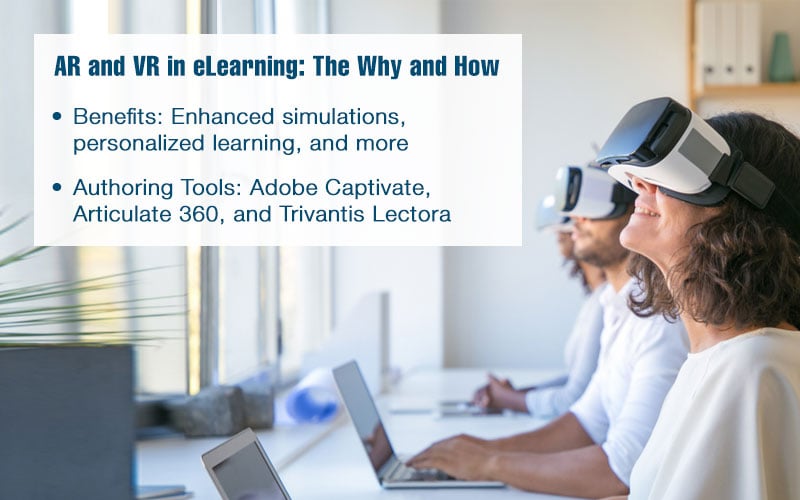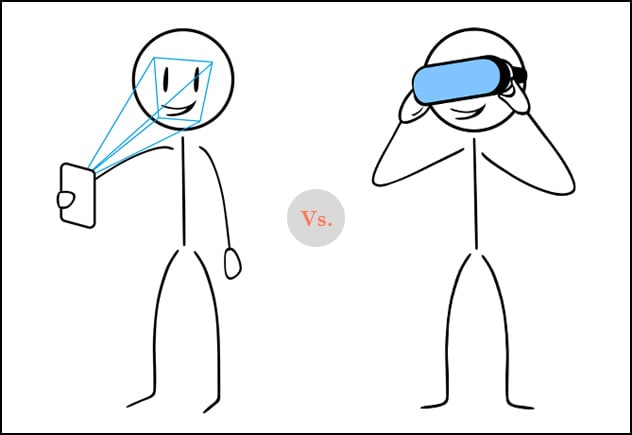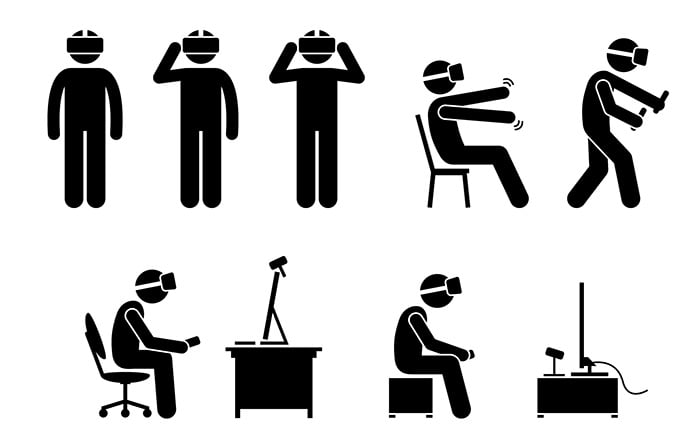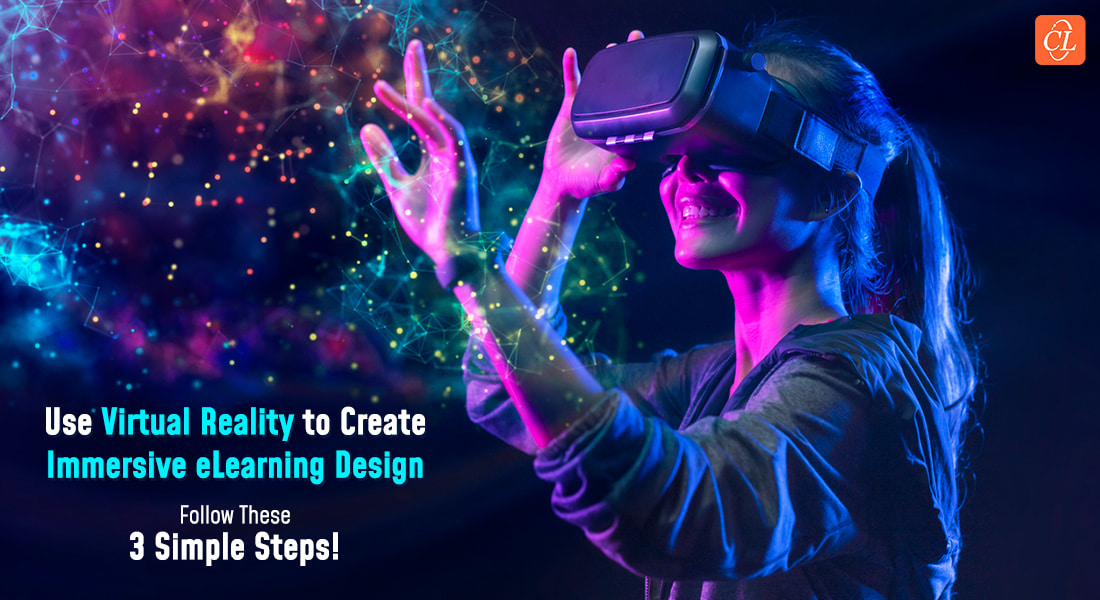The Best of Authoring Tools for AR and VR in E-learning

Augmented Reality (AR) and Virtual Reality (VR) have taken the world by storm, benefiting many industries ever since they appeared on the horizon. Since they help provide a high-level of engagement to corporate learners in eLearning, incorporating AR and VR in eLearning is sure to impact your return on investment (ROI) positively. With recent advances in authoring tools, using AR/VR in your online training becomes very simple, if not a cakewalk.
Though AR and VR technologies have been around for some time, there is still some confusion about whether they are the same or entirely different. So, let’s clear the air by first stating that AR and VR are different, and then going through the differences between them. Towards the end, we will also look into the authoring tools that help in creating AR and VR-based eLearning courses.
Explore why rapid eLearning paves way to evolving at the speed of business.
Augmented Reality vs. Virtual Reality

| Augmented Reality | Virtual Reality |
| Overlays or adds digital elements/imagery to live view | Immerses the user in a replicated/imagined world, shutting down the physical world |
| Uses clear lenses | Uses opaque headsets |
| E.g. Snapchat lenses, Pokemon Go game | E.g. Video games, flight simulations |
Let’s now discuss why you should use AR and VR in your corporate training.
Why Use Augmented Reality and Virtual Reality in E-learning?
1. Enhanced Simulations
The idea behind AR and VR technologies is to completely immerse learners in a virtual situation.
The audio devices and the headsets allow plugging out any external distractions and concentrating on the virtual learning activity.
For instance, use AR and VR for online compliance safety training simulations. Enable learners to step into a virtual learning environment and interact with virtual elements in real-life setups to prevent workplace accidents and injuries. You can also use simulations in eLearning courses to provide a highly engaging learning experience to your corporate learners.
2. Personalized Learning
AR and VR technologies allow you to provide your learners a chance to choose their own learning path and focus on filling the gaps in their learning. They get to have a more physical connection with the online learning content through which they venture down their different learning paths.
3. More Options for Gamification
With AR and VR technologies, your learners can earn tangible badges and rewards as well as physically move up leaderboards. As opposed to online gamification, AR and VR allow learners to physically interact with points and badges and even hold them in their hands. And who hasn’t heard of the famous game, Pokémon Go that swept the gaming world with AR technology?
4. Advanced Learning Analytics
With AR and VR, you can have more advanced learning analytics. You will now be able to track your learners’ eye movements to gauge their level of engagement with the training. These results can then be used to make improvements to the course, making them much more learner-friendly.
5. Assessments with Visual Feedback
VR technology facilitates branching scenarios and online simulations for assessments. It allows recording the learner’s performance and tracking final results. This enhances the evaluation because learners will be able to view the recording to identify where or how they went wrong.
Those were the 5 benefits of using AR and VR in eLearning. Read on to know how authoring tools can help with developing AR and VR in e-learning.
Authoring Tools that can be Used to Develop Augmented and Virtual Reality in E-learning
1. Adobe Captivate 2019
This rapid authoring tool provides an intuitive user interface, hotspots, markers, interactives, and 360° media assets that help develop AR and VR. You can use 360° learning experiences with overlays to augment learning landscapes. 360° photos and videos offer immersive playback by capturing real-world experiences.
Another amazing feature offered by Adobe Captivate 2019 is interactive videos that enhance the virtual reality experience. The ‘automated click and replace interaction’ allows you to quickly replace interactions without any programming, saving you huge amounts of time. Also, this tool offers responsive drag-and-drop interactions that provide an appealing and engrossing learning experience.
Example
Use Captivate 2019 to make employee onboarding more engaging and immersive with virtual reality. Offer them near real-life scenarios using VR headsets. Help your new hires explore your organization and actively engage with the workplace environment. You can use this tool for a virtual tour – display text and images, play audio or video. A scavenger hunt is a great idea where they can collect badges after visiting different departments and answering related questions about the company and its culture. Captivate 2019 also offers GPS for real-time coordinates that can enhance the onboarding experience for your employees.

2. Articulate 360
Augmented reality can easily be simulated with this authoring tool using its many features. Markers to add hover-and-reveal and click-and-reveal callouts provide an interactive learning experience along with sliders, interactive surveys, and quizzes. Storyline 360 also offers an intuitive user interface that helps developers to easily change the interface language and create a familiar interface. Another feature, motion paths in animations, offers 10 different motion paths to move objects from their initial position, making training more fun for learners.
Example
Storyline 360 can use AR and VR for compliance safety training (through simulations to prevent workplace hazards and injuries). Boring and time-consuming safety training in a laboratory can be turned into an engaging learning point for your learners with augmented reality. They can learn about the safety precautions they need to take while working in a laboratory without fearing the consequences of mistakes. Using a virtual environment, sound, and other stimuli, you can provide an immersive but safe environment for your employees by overlaying computer-generated information on the augmented reality screens.
The feature ‘Trigger action when objects intersect’ helps developers to create some action when one object collides with another. ‘Content library 360 media’ for characters, photos, icons, illustrations, and videos all help create an immersive augmented reality. Storyline 360 offers markers that a camera can recognize, which can be used as calibration points to align and overlay a computer-generated image or 3D project. Another feature, ‘Touchscreen gesture support’ allows learners to drag, swipe, and pinch-to-zoom on their mobile devices.

3. Lectora Online
Although this rapid authoring tool doesn’t support the creation of augmented reality or the use of GPS for real-time coordinates with AR, it does allow importing VR and having overlaid hotspots. You can also create or import animations to enhance the virtual reality experience for your learners with Lectora Online.
Example
When you use Lectora Online for your sales executives’ product training, they will understand the product features better with a visual, hands-on experience through VR. They can be shown the product features with VR which not only improves their knowledge retention but also makes training fun.
EndNote
Though using AR and VR has large cost implications, restricted mobility, and the need for a dedicated learning space, they do offer better training outcomes. According to Bloomberg, AR and VR technologies are trending and its market size is forecasted to reach USD 571.42 Billion by 2025. While this was about AR and VR, are you aware of other trends in eLearning that are ruling and will continue to do so in the future? Here’s our free eBook—eLearning Trends for 2020—that you can download to uncover 21 such trends.





